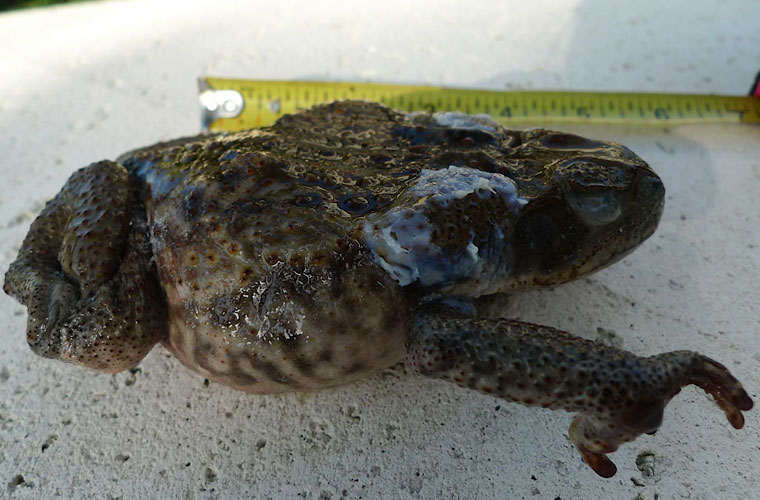
INDIAN RIVER COUNTY — It was about six weeks ago that Michael Fuller noticed his 1 1/2-year-old English Setter, Major, was severely foaming at the mouth and shaking his head.
So he immediately rinsed out the dog’s mouth, rushed him from their Ocean Pearl home in Vero Beach to Highlands Animal Hospital in Sebastian, where the veterinarian promptly treated Major for toad venom poisoning.
From there, Fuller took his dog to an emergency-care animal hospital in Melbourne, where Major spent the night connected to a heart monitor before returning home.
“He’s fine now,” Fuller said.
Major is fine because Fuller, who moved to the barrier island from the Kansas City area 4 1/2 years ago, knew exactly what to do if he suspected his dog had licked, bit into or tried to pick up a cane toad.
And how did he know?
“Fortunately, I had done some reading on these toads,” Fuller said. “We’ve seen a few different toads around our house since we moved here, so I did some research on them and learned the difference between southern toads and cane toads.
“I found out the cane toads are very toxic to dogs,” he added, “as well as what symptoms to look for and what to do if your dog comes into contact with one.”
Major being a larger breed helped, too, because the toad toxins work faster on smaller dogs.
Also, many smaller breeds, especially terriers, are bred to chase small prey, such as rats, snakes and toads.
Unlike southern toads, which are indigenous to the southeastern U.S., cane toads are native to Central and South America.
However, they have been introduced to other parts of the world, including Florida, because they were believed to help eradicate pests from sugar cane.
According to the Florida Fish and Wildlife Conservation Commission (FWC), the present population of these large, terrestrial toads in this state originated in 1955 as a result of the accidental release of approximately 100 toads by an importer at the Miami International Airport.
They began to spread when a canal was constructed linking the Blue Lagoon with South Florida’s extensive canal system in 1958.
Until recently, however, they had not migrated to Indian River County, though they had been found in Martin and St. Lucie counties.
“We were told that cane toads hadn’t been reported in our area,” Fuller said. “Even the FWC website didn’t have them in our county.”
After Fuller captured what he believed to be cane toads on his property, his wife, Mary, contacted the FWC Northeast Regional Office in Ocala and sent the agency a photograph in hopes of getting the toad identified.
The FWC’s Ryan DeSimone replied with an email saying he had forwarded the photograph to several biologists, including one in the exotic species department.
“The toad was positively identified as a cane toad,” DeSimone wrote. “There have not been any other reports of cane toads in Vero Beach. However, there have been positive reports of them north and south of the area.”
Fuller said neighbors in his community also have seen cane toads, which are known to be prolific breeders.
“I’m on guard,” Fuller said. “Dogs are attracted to things that move, that are alive, and they’ll go right up to them. I typically see the toads at night, around night lights, looking for insects. I’ve caught three of them in the last two weeks, and I know there are at least two more hanging around here.”
Cane toads can be poisonous to humans, too, and should not be picked up by hand. The FWC website said the toads’ secretions can irritate the skin and burn the eyes of those who handle them.
Various websites say the most humane way to kill cane toads is to catch them, bag them and put them in a freezer for three days.
“From what I’ve seen in the biologists’ reports, they’re not real common in that area,” FWC spokesman Greg Workman. “But if people are starting to see them, it’s only a matter of time before you see more of them.
“There’s really nothing you can do to keep them away, so people need to be aware that they’re there – especially dog owners – be careful with their dogs.”
The Fullers have done their part.



